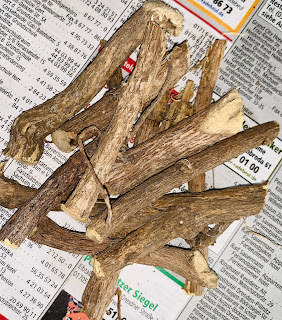Glyceriza glabra: A Comprehensive Overview
Introduction
Glycyrrhiza glabra, commonly known as licorice, is a perennial herb native to parts of Europe and Asia. The plant is known for its sweet-tasting root, which has been used for centuries in various cultures for its medicinal properties.
Licorice plants can grow to about 1 meter (3 feet) in height. They have pinnate leaves, each comprising 9-17 leaflets, and produce blue to violet flowers arranged in loose inflorescences. The roots are long, thick, and fibrous, which are the primary parts used for their beneficial properties.

Botanical Name:
Glycyrrhiza glabra linn.
Family:
Papilionaceae
Urdu Names:
Mulaithi, Asalas-soos, Khoga Waley, Mithi Kaathi, Malkhuzgi, Malkhuzi, Khwazha, Malkhuzigi
English Names:
Liquorice, Glycyrrhiza
Parts Used:
Roots
Temperament:
Hot + Dry
Order:
1st
Geographical Source:
Pakistan, Spain, Sicily, England
Organoleptic Evaluation:
Taste: Sweet, slightly bitter, and sour
Texture: Fibrous, chewy, and slightly crunchy
Odour: Characteristic, pleasant, and slightly sweet
Appearance/Colour: Brownish yellow to grayish brown with a rough, fibrous texture
Flavor: Sweet, licorice-like with a slight bitterness
Pharmacological Actions / Functions:
These actions include
Demulcent (soothing)
Expectorant
Diuretic
Sedative
Gentle laxative
Concoctive (assisting in the preparation of medicine)
local stimulant
Anti-inflammatory properties.
Specific action:
Expectorant
Chemical Constituents:
The root of Glycyrrhiza glabra contains several active chemical constituents that contribute to its medicinal properties. These include
Glycyrrhizin
Glycyrrhetic acid
Isoliquiritin
Isoflavones
Polysaccharides
Simple sugars
Proteins
Amino acid
and mineral salts like calcium, sodium, potassium, iron, zinc, copper, phosphorous, magnesium, manganese, silicon, and selenium.
It also contains vitamins like B1, B2, B3, B5, E and C. Pectins, starches, resins, and gums. Each of these compounds plays a significant role in the pharmacological effects of the plant.
Mode of Action:
1. Anti-inflammatory:
Glycyrrhizin, one of the primary active compounds in licorice, acts as an anti-inflammatory agent by inhibiting the enzyme 11Beta-hydroxysteroid dehydrogenase. This enzyme is responsible for converting active cortisol into its inactive form. By inhibiting this enzyme, glycyrrhizin increases the levels of cortisol, a natural anti-inflammatory hormone, in the body. This increased cortisol helps in reducing inflammation and has a protective effect on the stomach lining, potentially aiding in the treatment of digestive issues.
2. Anti-tussive:
Licorice is effective in relieving coughs by soothing the throat and reducing irritation. It inhibits the activity of the enzyme 11Beta-HSD, which normally converts inactive cortisone into active cortisol. By inhibiting this enzyme, licorice can increase cortisol levels, helping to calm throat irritation. Additionally, it acts as an expectorant, aiding in the loosening and expulsion of mucus from the respiratory tract. Its demulcent properties form a protective film over the mucous membrane in the throat, further alleviating cough symptoms.
Medicinal Uses:
- The root of Glycyrrhiza glabra is highly valued in traditional medicine, particularly in Unani medicine, where it has been used for centuries It is considered to have a hot and dry temperament and is known for its suppurative (promoting the discharge of pus), demulcent, and lenitive (soothing) properties.
- It is effective in relieving thirst and cough, removing unhealthy humors, and acting as a diuretic and emmenagogue (promoting menstrual flow). It is particularly useful in treating asthma and irritable conditions of the bronchial passages.
- Licorice is reputed for its ability to treat hoarseness of voice, a condition commonly addressed in Unani medicine. It is employed for relieving sore throats, asthma, and laryngeal irritation. Due to its pleasant flavor, it is often used for flavoring medicinal decoctions and as a base for pills. In cases of coughs and catarrhal affections of the throat and pulmonary mucus membrane, as well as dysuria (painful urination) and edema of the belly due to urinary troubles, licorice proves to be beneficial.
- The compound licorice powder, which includes Senna and sulfur, acts as a mild laxative. In larger doses, licorice exhibits mild mineralocorticoid and anti-inflammatory actions, making it useful in the management of rheumatoid arthritis and Addison’s disease.
Compound Preparations:
Sherbet A`ijaz
L`aooq Sapistan
Itrifal Mundi
Banadiqal Bazur
Tiryaq-i-Masana
Hab Awaz Kusha
Hab Maghz Badam
Dawai Sandal
Safuf Lodh
Safuf Longa
Sherbet Faryad Ras
Laooq Bihdana
Laooq Nazla
Laooq Amaltas.
Dosage:
The recommended dosage of licorice root is typically 3 to 6 grams.
Corrigents:
Cochlospermum religiosum Alston is used as a corrigent in kidney ailments, while Rosa damascena Mill. is used in splenic disorders.
Tenedium:
Cochlospermum religiosum Alston is used for pain or other disorders of the thoracic region, and Plantago ovata is used in mucous membrane disorders.
Side Effects:
While licorice has numerous medicinal benefits, it can cause side effects when taken in large doses. These side effects include sodium retention and potassium loss, which can lead to hypertension, water retention, and electrolyte imbalance. Therefore, it is important to use licorice in appropriate doses and under the guidance of a healthcare professional.
Prescription:
1-For Stomach Diseases:
(Stomach ulcer, Heart Burn, Dyspepsia)
- licorice (Mulethi) 10g
- Fennel (Sanoof) 10g
- Turmeric (Haldi) 5g
- Coriander (Kashneez) 10g
- Soda Bicarb 2g
- Crystal sugar (Meshri) 50g
Mix all ingredients well and make a fine powder then fill capsule.
2 time after meal with water
2- For Respiratory Diseases:
(Cough, Asthma, Common cold etc)
Joshanda / Syrup
Licorice (Mulethi) 20g
Fennel (Sanoof) 10g
Jujube (Unab) 20g
Violet (Benafsha) 20g
Ephedra (Soma kalpa) 20g
Hyssopus (zofa) 10g
Althaea Officinalis (Khatmi) 10g
Mix all ingredients and make a syrup or joshanda.
Conclusion:
Glycyrrhiza glabra is a plant of immense medicinal value with a rich history of use in traditional medicine. Its diverse therapeutic properties make it a versatile remedy for various health conditions. However, due to potential side effects, it is essential to use licorice judiciously and under the guidance of a healthcare professional. As research continues, the full potential of this remarkable plant is likely to be further understood and utilized.
